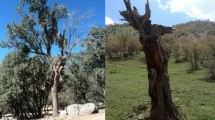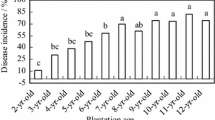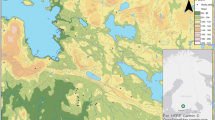Abstract
Austrocedrus chilensis forests suffer from a disease caused by Phytophthora austrocedrae, which is found often in wet soils. We applied three widely used modelling techniques, with different data requirements, to model disease potential distribution under current environmental conditions: Mahalanobis distance, Maxent and Logistic regression. Each model was built using field data of health condition and landscape layers of environmental conditions (distance to streams, slope, aspect, elevation, mean annual precipitation and soil pH NaF). We compared model predictions by area under the receiver operating characteristic curve and Kappa statistics. A reasonable ability to predict observed disease distribution was found for each of the three modelling techniques. However, Maxent and Logistic regression presented the best predictive performance, with significant differences with respect to the Mahalanobis distance model. Our results suggested that if good absence data are available, Logistic regression should be used in order to better discriminate sites with high risk of disease. On the other hand, if absence data are not available or doubtful, Maxent could be a very good option. The three models predicted that around 50% (49–56%) of the currently asymptomatic forests are located on sites at risk of disease according to abiotic factors. Most of these asymptomatic forests surround the current diseased patches, at distances lower than 100 m from diseased patches. Management considerations and the scope of future studies were discussed in this article.




Similar content being viewed by others
References
Baccalá N, Rosso P, Havrylenko M (1998) Austrocedrus chilensis mortality in the Nahuel Huapi National Park (Argentina). For Ecol Manage 109:261–269
Bergot M, Cloppet E, Pérarnaud V, Déqué M, Marçais B, Desprez-Loustau ML (2004) Simulation of potential range expansion of oak disease caused by Phytophthora cinnamomi under climate change. Glob Change Biol 10(9):1539–1552
Brasier CM (1996) Phytophthora cinnamomi and oak decline in southern Europe. Environmental constraints including climate change. Ann For Sci 53:347–358
Brotons L, Thuiller W, Araújo M, Hirzel A (2004) Presence-absence versus presence-only modelling methods for predicting bird habitat suitability. Ecography 27:437–448
Browning DM, Beaupré SJ, Duncan L (2005) Using partitioned Mahalanobis D 2(k) to formulate a GIS-based model of timber rattlesnake hibernacula. J Wildl Manage 69(1):33–44
Calí SG (1996) Austrocedrus chilensis: estudio de los anillos de crecimiento y su relación con la dinámica del “mal del ciprés” en el Parque Nacional Nahuel Huapi, Argentina. Thesis, Universidad Nacional del Comahue, Bariloche, Argentina
Colmet Dâage F, Lanciotti ML, Marcolín A (1995) Importancia forestal de los suelos volcánicos de la Patagonia Norte y Central. Available from Instituto Nacional de Tecnología Agropecuaria, Bariloche, p 28
DeVries RJ (2005) Spatial Modelling using the Mahalanobis statistic: two examples from the discipline of plant geography. In: Zerger A, Argent RM (eds) Proceedings of the international congress on modelling and simulation. Modelling and Simulation Society of Australia and New Zealand, pp 1368–1374
Díaz-Vaz J (1985) Austrocedrus chilensis. Descripción anatómica. Bosque 6(1):49–50
Eckert S, Leuggern AG (2006) A contribution to sustainable forest management in Patagonia. Object-oriented classification and forest parameter extraction based on ASTER and Landsat ETM+ data. Thesis, Mathematisch-naturwissenschaftlichen Fakultät, Universität Zürich
El Mujtar V (2009) Análisis integrado de factores genéticos, bióticos y abióticos para la formulación de una nueva hipótesis sobre la etiología del “mal del ciprés”. Doctoral thesis, Universidad Nacional de la Plata, La Plata, Argentina
Elith J, Graham C, Anderson R et al (2006) Novel methods improve prediction of species’ distributions from occurrence data. Ecography 29:129–151
Erwin DC, Ribeiro OK (1996) Phytophthora diseases worldwide. APS Press, St. Paul
Fielding AH, Bell J (1997) A review of methods for the assessment of prediction errors in conservation presence/absence models. Environ Conserv 24:38–49
Gibbs JN, Lipscombe MA, Peace AJ (2008) The impact of Phytophthora disease on riparian populations of common alder (Alnus glutinosa) in southern Britain. Eur J For Pathol 29(1):39–50
Giraut M, Ludueña S, Postiglioni A, Rey C, Dente V, Sol I (2002) Atlas digital de los recursos hídricos superficiales de la República Argentina. INA, Subsec. Recursos Hídricos, Presidencia de la Nación. Buenos Aires, Argentina
Gobbi M (1999) Austrocedrus chilensis management: effects on microsites and regeneration. Int J Ecol Environ Sci 25:71–83
Gobbi M, Schlichter T (1998) Survival of Austrocedrus chilensis seedlings in relation to microsite conditions and forest thinning. For Ecol Manage 111:137–146
Greslebin AG, Hansen EM (2009) The decline of Austrocedrus forests in Patagonia (Mal del Ciprés): another Phytophthora-caused forest disease. In: Goheen EM, Frankel SJ (eds) Proceedings of the fourth meeting of the International Union of Forest Research Organizations (IUFRO) Working Party S07.02.09, Phytophthoras in forests and natural ecosystems. U.S. Department of Agriculture, Forest Service, Pacific Southwest Research Station, Albany, CA
Greslebin AG, Hansen EM (2010) Pathogenicity of Phytophthora austrocedrae on Austrocedrus chilensis and its relation with “Mal del Ciprés” in Patagonia. Plant Pathol 59(4):604–612
Greslebin AG, Hansen E, Sutton W (2007) Phytophthora austrocedrae sp. nov., a new species associated with Austrocedrus chilensis mortality in Patagonia (Argentina). Mycol Res 11(3):308–316
Hansen EM, Goheen DJ, Jules ES, Ullian B (2000) Managing Port-Orford-cedar and the introduced pathogen Phytophtora lateralis. Plant Dis 84:4–14
Hellgren EC, Bales SL, Gregory MS, Leslie DM, Clark JD (2007) Testing a Mahalanobis distance model of black bear habitat use in the Ouachita Mountains of Oklahoma. J Wildl Manage 71(3):924–928
Hernández P, Graham C, Master L, Albert D (2006) The effect of sample size and species characteristics on performance of different species distribution modelling methods. Ecography 29:773–785
Irisarri J (2000) La propuesta de reclasificación de los Andepts de Argentina, de acuerdo al Orden Andisoles. In: Proceedings of the workshop soil taxonomy, INTA, AICET, AACS, Buenos Aires
Irisarri J, Mendía J, Roca C, Buduba C, Valenzuela F, Epele F, Fraseto F, Ostertag G, Bobadilla S, Andenmatten E (1995) Zonificación de las tierras para la aptitud forestal de la Provincia del Chubut. Available from Dirección General de Bosques y Parques de la Provincia del Chubut. Digital format
Jenness J (2003) Mahalanobis distances (mahalanobis.avx) extension for ArcView 3.x, Jenness Enterprises. Available from: http://www.jennessent.com/arcview/mahalanobis.htm. Accessed Dec 2008
Johnson CJ, Gillingham MP (2005) An evaluation of mapped species distribution models used for conservation planning. Environ Conserv 32(2):1–12
La Manna L (2005) Caracterización de los suelos bajo bosque de Austrocedrus chilensis a través de un gradiente climático y topográfico en Chubut, Argentina. Bosque 26(2):137–153
La Manna L, Rajchenberg M (2004a) The decline of Austrocedrus chilensis forests in Patagonia, Argentina: soil features as predisposing factors. For Ecol Manage 190:345–357
La Manna L, Rajchenberg M (2004b) Soil properties and Austrocedrus chilensis decline in Central Patagonia, Argentina. Plant Soil 263:29–41
La Manna L, Mateucci SD, Kitzberger T (2008a) Abiotic factors related to the incidence of Austrocedrus chilensis disease at a landscape scale. For Ecol Manage 256:1087–1095
La Manna L, Buduba C, Irisarri J (2008b) Los Suelos del Valle 16 de Octubre, Provincia del Chubut. Patagonia For 14(2):13–16
La Manna L, Carabelli F, Gómez M, Matteucci SD (2008c) Disposición espacial de parches de Austrocedrus chilensis con síntomas de defoliación y mortalidad en el Valle 16 de Octubre (Chubut, Argentina). Bosque 29(1):23–32
Liu C, Berry P, Dawson T, Pearson R (2005) Selecting thresholds of occurrence in the prediction of species distributions. Ecography 28:385–393
Loguercio G, Burschel P, Rey M (1999) El bosque de Ciprés de la Cordillera: su conservación y uso. Available from Centro de Investigación y Extensión Forestal Andino Patagónico, Folleto de divulgación 14, Esquel, Chubut, p 22
Loiselle B, Howell C, Graham C, Goerck J, Brooks T, Smith K, Williams P (2003) Avoiding pitfalls of using species-distribution models in conservation planning. Conserv Biol 17(6):1–10
Manel S, Williams HC, Ormerod SJ (2001) Evaluating presences-absence models in ecology: the need to account for prevalence. J Appl Ecol 38:921–931
Marsden S, Fielding A (1999) Habitat associations of parrots on the Wallacean islands of Buru, Seram and Sumba. J Biogeogr 26:439–446
Meentemeyer R, Rizzo D, Mark W, Lotz E (2004) Mapping the risk of establishment and spread of sudden oak death in California. For Ecol Manage 200:195–214
Mundo IA, El Mujtar VA, Perdomo MH, Gallo LA, Villalba R, Barrera MD (2010) Austrocedrus chilensis growth decline in relation to drought events in northern Patagonia, Argentina. Trees Struct Funct 24(3):561–570
Núñez M (2009) Cambio climático en Argentina: proyecciones con el uso de modelos físico-matemáticos. In: Castillo Marín N (ed) El cambio climático en Argentina. Secretaría de Ambiente y Desarrollo Sustentable, Buenos Aires
Pastorino M, Fariña M, Bran D, Gallo L (2006) Extremos geográficos de la distribución natural de Austrocedrus chilensis (Cupressaceae). Bol Soc Argent Bot 41:307–311
Pearce J, Ferrier S (2000) Evaluating the predictive performance of habitat models developed using logistic regression. Ecol Model 133:225–245
Pearson R, Thuiller W, Araujo M, Martinez-Meyer E, Brotons L, McClean C, Miles L, Segurado P, Dawson T, Lees D (2006) Model-based uncertainty in species range prediction. J Biogeogr 33:1704–1711
Pearson R, Raxworthy C, Nakamura M, Townsend P (2007) Predicting species distributions from small numbers of occurrence records: a test case using cryptic geckos in Madagascar. J Biogeogr 34:102–117
Phillips S, Dudík M (2008) Modeling of species distributions with Maxent: new extensions and a comprehensive evaluation. Ecography 31:161–175
Phillips S, Anderson R, Schapired R (2005) Maxent software for species distribution modeling. Available on: http://www.cs.princeton.edu/_schapire/maxent
Phillips S, Anderson R, Schapired R (2006) Maximum entropy modeling of species geographic distributions. Ecol Model 190:231–259
Raffaele E, Gobbi ME (1996) Seed bank composition and variability in Austrocedrus chilensis forest sites in Patagonia. Argent Int J Ecol Env Sci 22:59–72
Ramsey F, Schafer D (1997) The statistical Sleuth: a course in methods of data analysis. Duxbury Press, Belmond
Relva M, Westerholm C, Kitzberger T (2008) Effects of introduced ungulates on forest understory communities in northern Patagonia are modified by timing and severity of stand mortality. Plant Ecol 201(1):11–22
Rotenberry JT, Preston KL, Knick ST (2006) GIS-based niche modeling for mapping species’ habitat. Ecology 87(6):1458–1464
Schadt S, Revilla E, Wiegand T, Knauer F, Kaczensky P, Breitenmoser U, Bufka L, Červený J, Koubek P, Huber T, Staniša C, Trepl L (2002) Assessing the suitability of central European landscapes for the reintroduction of Eurasian lynx. J Appl Ecol 39:189–203
Soil Survey Staff (1999) Soil taxonomy: a basic system of classification for making and interpreting soil surveys, 2nd edn. Agriculture Handbook 436. Natural Resources Conservation Service, USDA, U.S. Government Printing Office, Washington, DC
Swets JA (1988) Measuring the accuracy of diagnostic systems. Science 240:1285–1293
Varsavsky E, Bettucci L, Rodríguez D, Gómez C (1975) Observaciones preliminares sobre la mortalidad del ciprés (Austrocedrus chilensis) en los bosques patagónicos. Pub. Fund. Bariloche No. 19, Bariloche, p 11
Veblen TT, Burns BR, Kitzberger T, Lara A, Villalba R (1995) The ecology of the conifers of southern South America. In: Enright NS, Hill RS (eds) Ecology of the southern conifers. Melbourne University Press, Melbourne, pp 120–155
Venette RC, Cohen SD (2006) Potential climatic suitability for establishment of Phytophthora ramorum within the contiguous United States. For Ecol Manage 231:18–26
Zobel DB, Roth LF, Hawk GM (1985) Ecology, pathology, and management of Port-Orford-cedar (Chamaecyparis lawsoniana). General Technical Report PNW-184. U.S. Department of Agriculture, Forest Service, Pacific Northwest Forest and Range Experiment Station, Portland, OR, p 161
Acknowledgments
Funding of this research by Consejo Nacional de Investigaciones Científicas y Técnicas (CONICET—PIP 5660 to A. Greslebin) is gratefully acknowledged. We appreciate Mariano Gómez and Juan Monges’s assistance during this work.
Author information
Authors and Affiliations
Corresponding author
Additional information
Communicated by R. Matyssek.
Rights and permissions
About this article
Cite this article
La Manna, L., Matteucci, S.D. & Kitzberger, T. Modelling Phytophthora disease risk in Austrocedrus chilensis forests of Patagonia. Eur J Forest Res 131, 323–337 (2012). https://doi.org/10.1007/s10342-011-0503-7
Received:
Revised:
Accepted:
Published:
Issue Date:
DOI: https://doi.org/10.1007/s10342-011-0503-7




